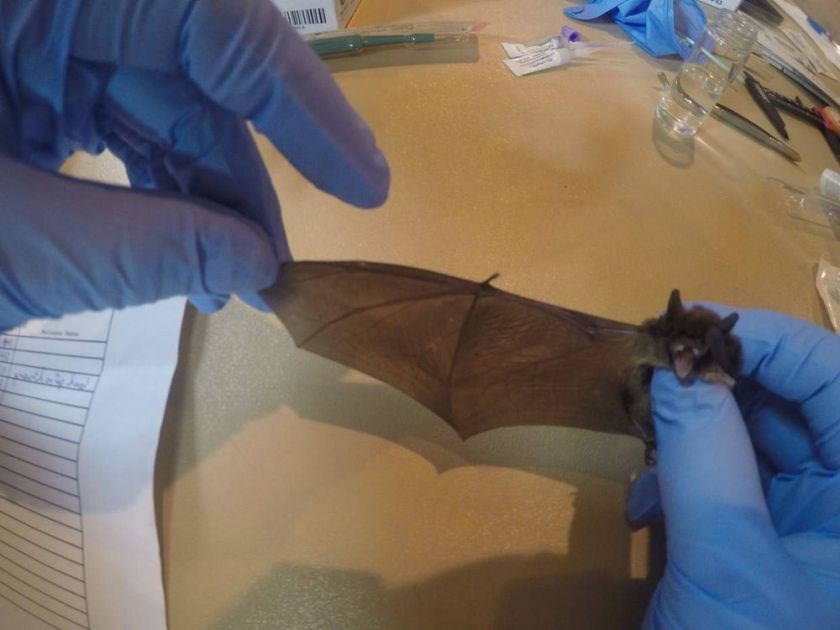When the sun goes down, Burvilla comes alive.
Look up at the roof of the 1905-era heritage home at Deas Island Regional Park in Ladner and watch as one set of tiny leathery wings after another squeezes out from the wood slats in the upper attic and takes flight.
“They’re pretty cool,” offers caretaker Peter Watts. “People get freaked out and ask: ‘Do they get in your hair when you’re walking around?’ But they’re quite easy to live with. Most of the time, you don’t even know they’re there.”
Burvilla is home to about 1,900 pregnant females — little brown and Yuma bats — that arrive in spring to give birth, rising to more than 3,250 bats with their young. “It’s the biggest colony that we know of in sa���ʴ�ý,” said Robyn Worcester, a natural-resource specialist with Metro Vancouver. “They’re an incredible resource in this park.”
The bats weigh just five to seven grams apiece, but they are gluttons, with agriculture being one of the major beneficiaries.
A lactating female bat consumes her body weight in insects every night. That’s a total of about 13 kilograms of insects consumed daily at Burvilla alone.
All that could change.
An introduced disease — white nose syndrome, first identified in North America in 2007 — could descend upon the colony any day now. Elsewhere in North America, the disease has been laying waste to one bat colony after another.
“It’s severe, one of the most significant wildlife diseases we’ve recorded in North America, in terms of the volume of wildlife affected and species,” said Patrick Burke, a biologist with South Coast Bat Conservation Society.
The disease is knocking on sa���ʴ�ý’s door after turning up in Washington state in 2016, just east of Seattle.
“We’re certainly within range, and we expect it,” said Orville Dyer, white nose response coordinator for the sa���ʴ�ý government. “If it behaves as it has elsewhere, the impact on some species is likely to be extreme.”
If that happens, Watts will miss the bats for their own sake, but also for the role they play in keeping down the mosquitoes that breed in the still and murky sloughs. “I wouldn’t want to be here without them,” he said. “It’s comforting to see them flying around in the evening.”
The disease involves a fungus that grows on the skin and causes the bats to wake up out of winter hibernation, forcing them to leave early to find food and water that may not be available, Burke said, adding the disease may also affect the immune system.
Once white nose syndrome arrives, the impacts gets increasingly worse over about three years, he said.
As few as two to 10 per cent of a colony might survive the disease, although the impact can vary from one colony to another. Naturally occurring bacteria on some bats’ skin may inhibit growth of the fungus. One potential solution is to put an inoculant, a probiotic, on the skin to help bats before hibernation.
As part of an ongoing study, about five to 10 per cent of the Burvilla bats are weighed and measured each year. The frequency of their calls allow researchers to differentiate between each species. The offspring of survivors seem to be less vulnerable to the disease.
Bat species that hibernate individually or in small numbers, including in trees or cracks in rocks, rather than in dense colonies, are thought to be less vulnerable, as well as larger bats and bats hibernating in colder climates.
“We hope if they are hibernating in smaller groups and colder temperatures, they might be more resistant here to the fungus,” Burke said.
At Burvilla, researchers are putting rice-sized tags in the bats to identify individual bats that return year after year.
Elsewhere, attempts are being made to sterilize hibernacula annually after the bats have left for the season.
“This is a very under-researched animal,” Worcester said.
Dyer said it’s important to track when and where the disease arrives in the province, and to monitor the impact on colonies. “There’s a whole bunch of question marks.”
It’s also important for researchers and cavers entering a bat roosting area to practise decontamination to prevent spreading the disease.
“We want to reduce the cumulative impacts that might make things worse or make recovery take longer,” Dyer said.
sa���ʴ�ý is home to at least 15 bat species, although recent acoustic detections could soon add to that number. Population estimates are difficult given the mobility of bats and their patchy distribution.
Bats throughout history have not had a good reputation, often viewed as a transmitter of rabies. In reality, the chances of a human contracting rabies from a bat are extremely remote.
If you discover a bat colony, call 1-855-9BC-BATS. For more information, visit bcbats.ca.



